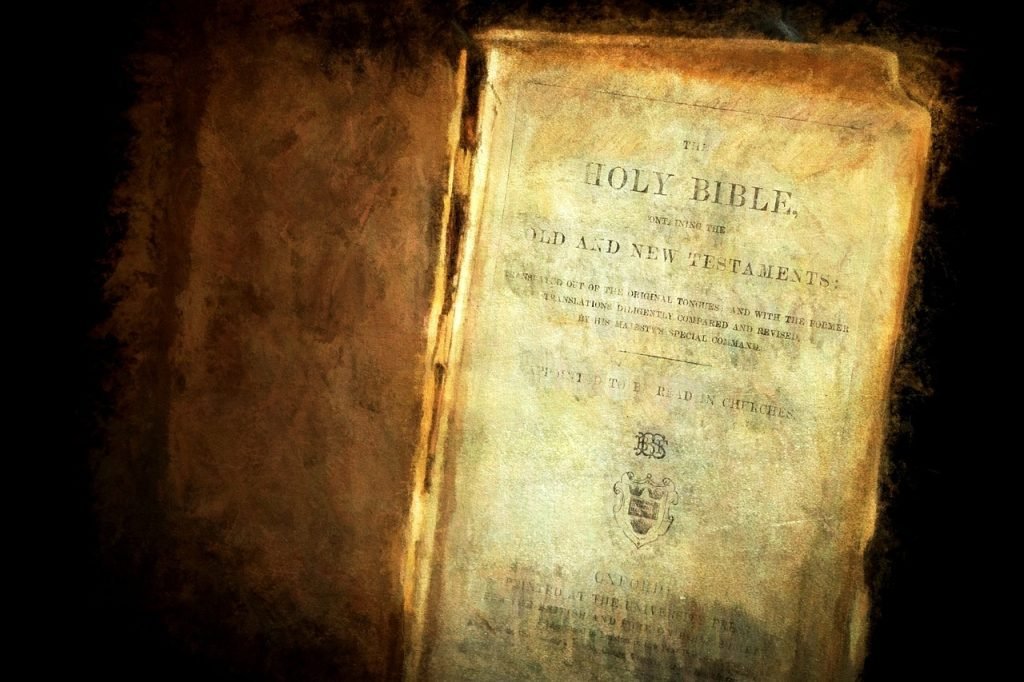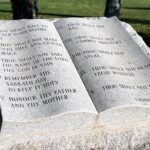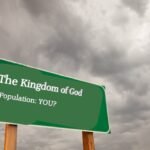“Biblios”
The Word of God is the foundation of knowledge.
“Sanctify them by Your truth. Your word is truth.” (John 17:17 [NKJV]).
“The Bible is not fable. Not stories without worth. Behold therein are treasures, not of the earth. A witness that is faithful, the Word of God is true. Behold therein are treasures; old & new. Answers there are given to questions of the mind. If you want to understand then go & search and find. Go & search to find!”[1] To go & search and find we must look to see and make sure the Bible is the true authentic Word of God.
The word, -Biblio-, [root.] -biblio- comes from Greek, where it has the meaning of “book.” This meaning is found in such words as: bible, bibliographer, bibliography, bibliophile. The Bible is simply the true revealed Word of God in the form of a book. The Bible is not fable, as many atheists, scoffers and unbelievers think the Bible is just made-up stories from antiquity. If the Bible is not true than we are lost.
Our goal in this study is to delve into the Bible, its authenticity, how it was written, created and preserved for us today.
All footnotes are found at the end of the paper.
- Jesus is the Word of God.
When we read the Bible, which we often call “the Word of God” we are actually reading what Jesus had to say to all mankind. Consequently, when I write of the “Word” of God, I capitalize the “W” in Word because Jesus was and is the Word of God. The Bible is God’s Words spoken to us by the Word of God.
John 1:1-3. Jesus was the Word. He created all things and He became flesh.
Heb. 4:12 “For the word of God is living and powerful, and sharper than any two-edged sword, piercing even to the division of soul and spirit…” The words God speaks are like a sword, cutting to the heart and judgment of man.
Psalms 149:6-8 Both the sword and the words of the Word will conquer this earth. See also Rev. 1:16; 2:12,16.
Which book is the sole and perfect Word of God? Is it the Koran (Quran)? “No doubt is there about this Book: It is a guidance to the God-fearing.”[2] Is it the Hindu Bhagavad Gita? “It is a work of undoubted integrity…”[3] What about the Book of Mormon? “The Book of Mormon is a volume of holy scripture comparable to the Bible.”[4] The ancient Egyptian “Book of the Dead” is another source of religion. The Book of The Dead “represents the system of theology promulgated by the priests of Ra the sun—god…”[5] These non-Christian books all claim to be the true word of God. None of these ancient works of religion are in agreement with the Biblical Word of God. We must know and understand that only the Christian Bible is the true Word of God. All other so called, “holy books” are false religions and are not the Word of God.[6]
Only the Holy Bible of Judaism and Christendom are the true and holy, perfect Word of God. “The Bible asserts of itself that it is the special revelation from God; it must therefore be acknowledged as claiming to be the right kind of source from which to derive a trustworthy knowledge of religious truth.”[7]
“All Scripture is God-breathed and is useful for teaching, rebuking, correcting and training in righteousness, so that the servant of God may be thoroughly equipped for every good work.” (II Tim. 3:16-17 [NIV]). God breathed from the mouth of God. God’s Words.
- The Old Testament.
The original writings of the Bible (Biblios) are called the Old Testament. Consisting of 39 separate books in three parts Law, writings and prophecy (future history). “…Originally written, [in], Hebrew and Aramaic, along with those related Semitic languages (such as Arabic, Assyrian, Phoenician, Ugaritic, and Syriac). The Old Testament gives us a wonderful look into “The history of the Hebrew people and of those neighboring countries with which they had contact.”[8] As time has moved on, the surrounding countries, names of leaders and geography as recorded in the Old Testament have consistently been proven truthful. All other religious books which purport to be god’s word use names, places and geographies which have never been shown to have existed. For example, the Book of Mormon uses places and names such as “Nephi”, “Lamanites”[9], Book of Ether” and “people of Jared.” Not one of these places or people’s names have ever been authentically identified in either history, archeology or geographically. Whereas, the place names and people of the Old Testament are now almost fully identified and shown to have existed.
Part A. The Law of Moses.
The first five books of the Bible are known as the “Pentateuch”. A word “derived from two Greek words, pente (‘five’) and teuchos (‘volume’), properly an adjective modifying biblos (‘book’), thus, ‘a five-volumed book.”[10] The Pentateuch consist of Genesis, Exodus, Leviticus, Numbers and Deuteronomy. If one were to highlight the spoken words of God, the Book of Leviticus would be almost completely highlighted. This section of the Bible deals with creation, Abraham and his descendants and the great man Moses with the formation of the nation of Israel and the Exodus into the promised land. These are called the books of the law because God formerly gave Moses His law (The Covenant- Exodus 34:27-28; Deut. 4:13; 5:2; 9:9).
Moses is considered the author of the Pentateuch. Many references point to his “book” and what God gave him to write down (Gen. 5:1; Ex. 32:32-33; 24:27; Deut. 31:24; 29:21,27; 30:9-10 and Joshua 23:6). The last chapter of Deuteronomy is considered to have been added by Joshua as it records the death and fate of Moses.
Part B The Prophets
The prophetic books of the Old Testament are broken into two categories. The “minor” prophets and the “major” prophets. This distinction has nothing to do with the importance of the book but the length of the book. Isaiah, Jeremiah and Ezekiel are the “major” prophets. The minor prophetic books are Hosea, Joel, Amos, Obadiah, Jonah, Micah, Nahum, Habakkuk, Zephaniah, Haggai, Zechariah and Malachi. Other prophetic books are Joshua, Judges, Samuel and Kings.[11]
Part C The Hagiographa (Writings).
This third section of the Old Testament is broken into two distinct sections, yet all are a part of the writings.
I. Poetical books.
Psalms, Proverbs and Job are a series of Hebrew poetry (Not always does one language of poetry translate into poetry in another language. It is sadly the case here where the poetic words of these books do not translate into English poetry).
II. The Writings which also contain poetry, history and culture.
The Song of Solomon, Ruth, Lamentations, Ecclesiastes, Esther, Daniel, Ezra and Nehemiah (Considered one book in Hebrew), The Book of Chronicles.
While the vast majority of the Old Testament was originally written in old Hebrew (Much different than the current Hebrew spoken and written in Israel today), parts are written in other Semitic family languages. For example, Daniel 2:4-7:28 is written in Aramaic because it was intended for a gentile audience.
In our reading of the Old Testament, we need to understand the basis of the languages it was written in, history of the Hebrew people and the surrounding cultures they encountered. Religion of the non-Hebrew nations, authorship of the books. Dates of the books and the historical and cultural contexts they were written in. Knowing who they were written to and the culture of the day vastly increases ones understanding of the Word of God.[12]
Paul distinctly informs us “All Scripture is given by inspiration of God, and is profitable for doctrine, for reproof, for correction, for instruction in righteousness,” (II Tim. 3:16 [NKJV]). Paul was referring to the only scripture known at his time- The Old Testament. At the end of his life Paul even asked for the scripture to be brought to him. (II Tim. 4:11). The Old Testament is as relevant today for us as it was for Paul and the first century Church of God. In his death, the apostle Paul testifies of the veracity of the Old Testament through the author of Acts, Luke the physician. “And when they had appointed him a day, there came many to him into his lodging; to whom he expounded and testified the kingdom of God, persuading them concerning Jesus, both out of the law of Moses, and out of the prophets, from morning till evening. (Acts 28:23-24). Paul preached Jesus and the kingdom of God from the Old Testament.
Part D of the Old Testament: The Septuagint-LXX.
During the reign of Ptolemy II Philadelphus of Egypt (285-246 B.C.) the Septuagint was translated. King Philadelphus being disposed to reading and libraries asked the Jewish delegation to translate the Hebrew Bible into Greek. It was intended to add this work to the Library of Alexandria. It is unfortunate for the history of the world that the Library of Alexandria burned to the ground in about 48 B.C.
What is the Septuagint? It is the Greek rendering of the Old Testament. This is the “bible” of the day used in the first century by both jews and Greeks. The Greek language and conquest had been so thorough of Judea that Greek was a major language in the first century. Called the LXX (Roman numeral 70) by scholars it was translated in 72 days. Also called the “Alexandrian version of the Old Testament, so named from the legend of its composition by seventy (Lat. Sepluaginta), or more exactly seventy-two translators.”[13] The LXX, “is the official and authoritative Bible of the Hellenistic Jews, having not only been formally accepted by the synagogue at Alexandria, but authorized by the authorities at Jerusalem.”[14]
With the formal acceptance of the accuracy of the Septuagint, the Jewish population of the diaspora now had a “bible” they could read in the language they were used to speaking. By this time, Hebrew was a minor language and thus even today we speak of the “Greek speaking world” of ancient history. For us today “The LXX. is of great importance in more than one respect. It was the first step towards that fusion of Hebraic with the Hellenic strain, which has issued in the mind and heart of modern Christendom.”[15] Indeed, it is the LXX that came down to the translators of the Greek into English in the early 1500, s.
- Dead Sea Scrolls
Located about a mile and a half from the northwest corner of the Dead Sea, the ancient ruined city of Qumran lies in wait of tourist visitation. The archeologically excavated city is located in the Judean desert about ten miles south of Jericho. Dry, small patches of dusty shrubs and an occasional goat or Bedouin passing by is all that remains of the city. Destroyed by Titus in about 68 A.D. some of the population of Essenes escaped to Masada.
The community of Qumran was a strict, anti-establishment Jewish sect who kept strict adherence to the Law of Moses and rejected the Oral Law of the Pharisees. A communal lifestyle was lived with daily devotions. Known as the Essenes, they either copied or saved ancient scrolls of the Old Testament, the apocrypha and other ancient writings.
1947 turned out to be a very big year for the ruined city of Qumran. Three shepherd boys of Arab decent were either herding their goats or looking for gold. They threw rocks into the caves above Qumran only to hear the breaking of pottery as the stones entered the caves. The next morning, Muhammed Ahmed el-Hamed went exploring and found scrolls encased in ancient pottery. What the world now calls the “Dead Sea Scrolls” were discovered by a young goat herding boy.[16]
The “Dead Sea Scrolls” are considered by many to be the most important archeological discovery in history. Theologically and religiously, the scrolls are of huge importance to us today. “The famous Dead Seas Scrolls are as relevant to the study of the New Testament as they are to the understanding of the Old, and any account of the New Testament archaeology would be incomplete without some mentions of their significance.”[17] Thus, the significance of the scrolls is a part of our study of the Bible (Biblios). The scrolls themselves antedate the New Testament and Christianity. Their discovery is “revolutionizing our knowledge of the textual criticism of the Hebrew Old Testament, of the Esses sect, and of the background of the New Testament.[18]
The scrolls “were made of animal skins and were written on the smooth side in the Hebrew square script with ink made from charcoal or iron… The scrolls date “between the middle of the third century B.C. to the middle of the first century A.D. They are earlier by a millennium than any previous known copy of the Bible…”[19] Today, most of the scrolls are housed in the Shrine of the Book Museum in Jerusalem. They are curated and studied for the understanding of the culture, history and theology they have brought down to our time. Interestingly, the Shrine of the Book Museum, can be lowered into the ground in time of war to protect it from an attack which could damage or destroy the scrolls.
A major portion of uncovering the truths of the Bible is to learn of its historic accuracy. Today, we do not have any original documents of either the Old or the New Testament. An original document is called an “autograph”. All subsequent copies are “copies” of the autograph. While scribes and copyist strive to accurately and correctly copy the documents, errors can and do creep in. The significance of the Dead Seas Scrolls is it gives us a glimpse into the very distant past as ever book of the Old Testament (Except Esther) is in one form or another represented in the Dead Sea Scrolls. The accuracy of the modern Bible in comparison to the accuracy of the Dead Sea Scrolls is remarkable. The historicity of the Bible and its accuracy and inerrancy of transcripts as copied from the original autographs shines brightly through the Dead Sea Scrolls.[20]
Now we begin to transition between the Old and New Testaments of the Word of God. “The unity between the Old and New Testaments is perhaps most obvious in the fact that the New Testament fully upholds the laws and commandment of God.”[21]
- New Testament
Consisting of 27 individual books written by nine separate authors the New Testament is remarkable for its coherent single message of hope for all mankind through the death, resurrection and redemption of Jesus the Savior. By the time of the first century Judaism had become a system of legalistic dos and don’ts based on the oral law rather than on saving grace. It was incumbent of Paul to say, “For by grace you have been saved through faith, and that not of yourselves, lest anyone should boast.” (Eph. 2:8 [NKJV]). Abraham was saved by faith as he “believed God, and it was accounted to him for righteousness. Therefore, know that only those who are of faith are sons of Abraham. And the Scripture, foreseeing that God would justify the Gentiles by faith preached the gospel to Abrahm beforehand saying ‘In you all the nations shall be blessed.’” (Gal. 3:6-8). For the Jews, anathema- Gentiles saved by God? God forbid!
Studying the New Testament should include “some understanding of Judaism, Hellenism and Paganism. The discovery of the Dead Sea Scrolls has contributed to the interpretation of the New Testament almost wholly in this area of background.”[22] It is evident in the New Testament that knowing the culture and history of the time is beneficial to our current centuries understanding. How many Herod’s are mentioned in the New Testament? Can multiple Herod’s cause confusion? Understanding the people and who the New Testament (letters/books) were written to expands ones understanding. “The message of the New Testament can be apprehended best when one has some comprehension of the world into which it first came. The literary, political, social, economic, and religious backgrounds of the first century are the context for the revelation of God in Christ.”[23]
The apostle Paul was both a Jewish Pharisee and a Roman citizen. His knowledge of both Greek and Hebrew and of the culture of the day greatly helped his ministry. One example, “Men of Athens, I perceive that is all things you are very religious; for or as I was passing through and considering the objects of your worship, I even found an altar with this inscription: TO THE UNKNOWN GOD. Therefore, the One whom you worship without knowing, Him I proclaim to you.” (Acts 17:23).
The New Testament is made up of four gospels (Matthew, Mark, Luke and John) giving the reader a glimpse into the life of Jesus and His gospel message of hope and salvation for all mankind. Jesus came preaching the gospel of the Kingdom of God (Mark 1:14). The book of Acts (Written by the physician Luke, who also wrote the gospel of Luke) is a short-detailed history of the early church. Next comes the epistles, both general and Pauline. Thirteen of the epistles were written by Paul and much of the book of Acts follows him around the Mediterranean and Europe as he spreads the gospel in the first century. Seven epistles were written by James, Peter, John and Jude. James and Jude being physical brothers of Jesus. The book of Hebrews shows the magnificence of the sacrifice of Jesus the Messiah for all mankind. The author of Hebrews is in dispute as there is no mention as to who wrote it. Paul, Barnabas and Apollos are the leading candidates for authorship and Paul is the most likely to have composed the book of Hebrews. The final book of the Bible is the Book of Revelation. Written by John sometime in the mid 90’s A.D. it is the Revelation of Jesus Christ as to what the future of the world will be like. It is also considered a most difficult book to read and understand.
Much of the New Testament is in the form of letters. Just as we would write to a loved one or a friend, the early Church writers wrote letters to people or to churches. Our personal letters often contain personal information, emotional, news and correctional information. Many letters we write are heart felt and sincere. The early apostles wrote in the same fashion, in fact, “Twenty-one of the twenty-seven books of the New Testament are letters (about 35 percent of the entire New Testament).”[24]
The early writings of the apostles and leaders of the Church of God were often written by scribes as the author dictated the letter. The New Testament was “meant to be read aloud again and again to specific congregations.”[25] Not everyone was literate so reading allowed gave everyone the opportunity to hear from the author. Once the letter was read by or to the named recipient (Church group such as Galatians, Ephesians or to an individual such as Timothy or Titus the letter was then “exchanged with other churches.”[26] Thus, the writings began to be copied and circulated as direct messages from the apostles to the early church.
How did the writings of the early first century New Testament Church of God come to be in our possession today as a part of the Holy Bible?
- The Canon of the New Testament.
“The Greek word kavwv means originally a straight rod or pole, and metaphorically what serves to keep a thing upright or straight, a rule.”[27] The word “canon” generally has two understandings, first is “the underlying meaning is that of rule” and second is “a list or catalogue, i.e. of books contains the rule.”[28] This Greek word we call the “canon” perfectly describes the Word of God. It is a series of books with rules to keep us on the straight and narrow path of Christianity.
How did the books of the Bible come to be? What was the process of choosing which letters to put into what we today call the “Holy Bible?” There are many writings, such as the Apocrypha which are not included in the final “canon.” When we look at the Bible, we begin to understand it best “when one has some comprehension of the world into which it first came. The literary, political, social, economic, and religious backgrounds of the first century are the context for the revelation of God in Christ.”[29] Context and culture are king and we must remember the books of the Bible were written to specific people in specific places for specific reasons in a world dominated by Rome and Caesar. The New Testament canon is simply “the collection of the Sacred Books of Christians.”[30]
We stated earlier how the churches of God would read and distribute the letters from the apostles and leaders of the first century church. As one can imagine, spurious, none Chrisitan letters began to spring up and confuse the brethren. Possibly as early as 51 A.D. Paul wrote “…not to be soon shaken in mind or troubled, either by spirit or by word or by letter, as if from us…” (II Thes. 2:2). It did not take long for false gospels (Gal. 1:6) to begin to supplant the original Word of God. The early Church of God needed to develop criteria and “guidance concerning which writings were deemed beneficial. They had to develop criteria by which Christian leaders could adopt texts as ‘Scripture.’ This authoritative collection of New Testament books is called ‘the canon.’”[31]
Doing the work of ministry, one does not think one is writing what will become part of the Holy Bible. Yet, the early apostles began to have this sense about what they wrote to the people of God. “There was not at first among the writers any idea that they were composing an infallible narrative. The freedom with which they used each other’s work, and with which the early texts were transmitted, excluded this. But there was the idea that the whole movement of the Church to which they gave expression was in a special sense divine. And this belief was the fundamental principle that determined the making of the writings of the first, or apostolic, age from the rest.”[32]
Canonization of the books of the Bible took a long period of time and consisted of three main unique areas of history and church culture. “First, the writings are quoted individually by authors who take the force of their witness for granted rather than making it a point of argument. Second, writers like Irenaeus and Origen, who were engaged in controversy, felt the necessity of defining their authorities, but did not appeal to any single church decision. Last came the verdict of the councils which followed the judgement of the leaders past and present, and drew an official distinction between the canonical and the apocryphal works.”[33] In some ways the canonization was an easy process. People were quoting the letters from the apostles; scholars were debating their authenticity and finally the church canonized the books of the New Testament.
We note in our understanding that “’Scripture’ means the written record of the authoritative word of God.”[34] The church noted the inspiration of these documents, their moral effect and finally the “historic testimony of the Chrisitan church will show what value was placed on these books…”[35]
What was the perspective of the apostles concerning what they sent out to the churches in the form of letters? Looking at scripture from the point of view of 2,000 years ago gives us a cultural glimpse into the creation of the canon. “The NT authors recognized God and Jesus as the ultimate authorities…Jesus gave his disciples special authority that translates into the authority of their written works (Matt. 16:19; 2 Cor.13:10). Paul claims authority as one ‘in Christ’ (2 Cor. 12:19) and under the Holy Sprit’s influence (I Cor. 7:40). NT authors regarded their message as the ‘word of God’” …Apostolic teaching was authoritative whether delivered in person or in writing (2 Thess. 2:15).[36] Historically the Bible is considered both inerrant and infallible.[37]
Through the long process of canonization, we can have complete and total confidence the Bible, as we have it, is the inerrant perfect Word of God. Through the many centuries, copies of copies of copies of the original autographs the Bible have remained true to its original Christian apostolic origin. In fact, with all the historical documentation of the New Testament (See the section on translations below) and even with “the numerous possibilities for error, the New Testament is probably the most trustworthy piece of writing that has survived from antiquity.”[38] Our study of the Bible and our trust and faith God has given us His pure Word is unshakeable. “Therefore, one can have full faith and confidence that the original Greek text-as preserved in the Byzantine text- is the very Word of God.”[39]
John was the last living apostle to write his gospel and epistles. By the time John wrote the first century was almost complete. The other apostles were either dead or scattered abroad. Jerusalem had been destroyed and over 1,000,000 Jews had died in the revolt of 70 A.D. The new fledgling Church of God had scattered around the Roman empire. Peter and Paul had shown their writings to be canonical. What of John and his roll in the creation of the canon?
It was the elderly John who put the order and approved of the writings which became the canon of the New Testament. “…the official canonization with the final arrangement of the books of the entire New Testament was accomplished by the apostle John in 96-99 A.D. As one of the last living apostles and the last living eyewitness of Christ’s transfiguration, John was uniquely qualified and chosen by Jesus to canonize the entire New Testament in its final form.”[40]
- History and development of translations into English.
The Bible is the Word of God and translating words from one language to another is not an exact science. In fact, words used in the King James Bible (KJV) (The “Authorized” Version) from 400 years ago can mean something very different today. Languages change over time and words like “cracknel” and “cumbereth” have different meanings today than in the past. Many of the words used in the King James Bible “have become obsolete. Its grammar, syntax and style, in places, has changed so much that the old language, already slightly archaic in 1611, has become almost unintelligible.”[41] Imagine attempting to translate the Greek of 2,000 years ago into Latin then back into Greek and then into Old English and trying to read it and understand its nuances today.[42]
Using the outline from the book, “Grasping God’s Word” by Duvall and Hays we will give a brief historical history and timeline of the development of the Bible translations into our modern English language.
Around the year 400 A.D. Jerome translated the Bible into Latin from the Greek and this was called the “Latin Vulgate”. For around 1,000 years the Latin Vulgate was the Bible of the English-speaking world, except Latin was not a commonly spoken or read language. Finally, around 1380 A.D. John Wycliffe made a word for word translation from Latin into English. Wycliffe was severely persecuted and soon (384) John Purvey created a better English version, using Wycliffe’s English Bible. With the invention of the printing press and the Protestant Reformation, demand began to grow for a Bible the common people could read. In 1526, William Tyndale produced an English version based on the Greek text rather than the Latin text used by Wycliffe. Tyndale was executed by the King of England for his translation.
In short succession during the 1500’s we have the Coverdale Bible, 1535; John Rogers translated what became known as the Matthew Bible, 1537. This became known as the Great Bible because of its large print and it was the first English Bible authorized to be read in the Church of England. When Mary, Queen of Scots took the throne as a Catholic, she began to persecute those who wanted the Bible in English. Many scholars fled to Geneva, Switzerland and from this we get the popular Geneva Bible (1560) used by the Puritans and William Shakespeare. The Bishop’s Bible was completed in 1568 and in 1593 the Catholic English version called the Douai-Rheims Bible.
1604 was a momentous year in England as King James I authorized a translation into English that all could understand. The days of persecuting the translators had passed and now even the King wanted a Bible. In 1611, the King James Authorized Version was printed and distributed. Still to this day, it is the most popular Bible found in homes across the English-speaking world. Because language changes over time the King James Version needed periodic updating. The KJV was updated and revised in 1629, 1638, 1729, 1762 and 1769. It is the 1769 revision of the KJV we have today on our bookshelves.
Since about the mid 1800’s numerous other English translations have arisen. Translations such as, English Revised Version (1881-1885), American Standard Version (1901), Revised Standard Version (1946-1952), New American Standard Bible (1971), New King James Bible (1979-1982), New Revised Standard Version (1989). Catholics translated two Bibles, New American Bible (1941-1970) and the Jerusalem Bible (1966). Good News Bible ((1976), New International Version: NIV (1973, 1978, 1984), New Century Version (1987), Contemporary English Version (1991-1995), New International Readers Version (1996-1996), New Living Translation (1966), Living Bible (1967-1971), The Message (1993-2002), God’s Word Translation (1995) New English Bible (1998), Today’s New International Version (2001), English Standard Version (2001), Holman Chrisitan Standard Bible (1999-2004) and the Common English Bible (2011).[43]
Seemingly there is a Bible for every choice of reader in the English language. This brings us to a very important topic. Are all Bibles created equal? Which translation is best? Are study Bibles better than modern language paraphrased Bibles? What is good for reading? Studying? Preaching and teaching? Does it matter which translation we use?
- Translations
Which English translation is best for us to read? In the theological world of Biblical translation there are two main paths of thought concerning the translation of the Greek, Latin and Hebrew texts into modern English. A decent understanding of these two thoughts and the Biblical versions they have created can help us pick the Bible translation we would like to read and study. We go into the following study with the understanding that 99.9% of the Biblical translations are in total agreement. There are places where names of people or places are spelled differently, some verses are left out and some added in other translations. But the overall accuracy of the Bible is so pure as to be unquestionably the work of God.
“There are two main approaches to translation: the formal approach (sometimes labeled ‘literal’ or ‘word for word’) and the functional approach (often called ‘idiomatic’ or ‘thought for thought’).”[44] The functional approach is usually very readable.
We will first look into the “Textus Receptus” used in the making of the King James Bible. Secondly, we will look at the two ancient manuscripts known as “Aleph, or Codex Sinaiticus… and B, or Codex Vaticanus.”[45] Codex Vaticanus and Sinaiticus are both from the fourth century A.D.
Part A: Textus Receptus: King James Version and modern translations.
The vast majority of the English-speaking world has used and enjoyed the King James Version (Authorized Version) of the Holy Bible since its first publication in 1611. For over 400 years it has been the best-selling book around the world year in and year out. Yet where did it come from? What ancient documents were used in its translation and is it still readable today with our modern English? Not until 1982 did the scholars of theology update the King James Version (KJV) into what we know as the New King James Version (NKJV).
The history of the translation of the KJV is unique and exciting to study. Early in church history there was beginning to be numerous copies of copies of the original autographs. So many so that Jerome was commissioned to “remedy the confusion produced by variations of the Latin text. Pope Damasus asked Jerome to undertake a revision, and the latter published a new text of the New Testament in A.D. 384…This version gradually became accepted as the standard text, and after a time was called the “Vulgata,” the first to use this name as a title being, it is said, Roger Bacon. In the Old Testament Jerome made a new translation directly from the Hebrew, as the Old Latin was based on the LXX (Septuagint), but in the New Testament he revised the existing version.”[46] The “Vulgata” (Know known as the Latin Vulgate) was the main text used to translate to the KJV. Thus, the basis of translation and accuracy of the KJV is based in antiquity. The underlying texts used for the KJV are known as the “Textus Receptus or TR.”[47]
Commissioned and presented to King James I of England, the KJV is today, for us full of archaic language and at times difficult to read. Language changes over time and the common language of 1611 English verses the 21st century English is at times like reading a foreign language. Yet, as stated by Catholic scholar, Alexander Geddes, “If accuracy and strictest attention to the letter of the text be supposed to constitute an excellent version, this is of all versions [KJV] the most excellent.”[48] Hard to read or not, the KJV is a most reliable and accurate translation into English. The methodology of the translators used was “committed to producing an English Bible that would be a precise translation, and by no means a paraphrase or a broadly approximant rendering.”[49] For the translators, accuracy was paramount over readability. It was the goal and “principle of complete equivalence [which] seeks to preserve all of the information in the text, while presenting it in good literary form.”[50] “Dynamic equivalence” of text is in complete juxtaposition of “complete equivalence” which will be discussed in the next section.
From 1979 to 1982 a group of translators worked on updating the KJV and published the New King James Version (NKJV). The NKJV conforms to the ancient KJV in thought and flow. One “discovers that the sequence and selection of words, phrases, and clauses of the new edition, while much clearer, are so close to the traditional that there is remarkable ease in listening to the reading of tither edition while following with the other.”[51] In short, the NKJV is easier to read in our modern English, conforms to the ancient texts in accuracy and updates and corrects some errors of the old KJV.
We will look at one obvious error of the KJV. King James I was Anglican and he kept Easter. The original translators of the KJV wanted to honor and not offend the King. Remember, Wycliffe was severely persecuted and a prior King had Tyndale burnt at the stake for translating the Bible into English. “And when he had apprehended him, he put him in prison, and delivered him to four quaternions of soldiers to keep him; intending after Easter to bring him forth to the people.” (Acts 12:4b [KNV]). The Greek word translated as “Easter” is Pascha, or Greek for Passover. Passover was “Jewish” and the King wanted nothing to do with it. “So, when he had arrested him, he put him in prison, and delivered him to four squads of soldiers to keep him, intending to bring him before the people after Passover.” (Acts 12:4 [NKJV]). This is one example of updates and corrections between the KJV and the NKJV.[52]
The KJV and now the NKJV is based on the “Textus Receptus” or the “Received Text” and is bolstered by over 5,000 Greek manuscripts and 8,000 Latin documents.[53] These texts (Textus Receptus manuscripts) are NOT the oldest Biblical manuscripts in existence but they by far outweigh the older manuscripts in volume and number of copies.
Part B: Vaticanus and Sinaiticus and newer English translations such as the New International Version.
The oldest extant translations are the codex Vaticanus and the codex Sinaiticus. The question becomes one of age and accuracy. Does an older translation make it more accurate? We will look at both of these very ancient documents. Both of these were found in the Egyptian desert where the drier air preserved them. The Textus Receptus (Or more clearly the Majority Texts) documents are from Greece, Italy and the northern Mediterranean where it is much more humid which deteriorates leather, papyrus and paper. Dry air is a document preserver, thus Vaticanus and Sinaiticus being found in the Egyptian desert are older documents.
I: Codex A, Sinaiticus.
A Biblical copy of the New Testament dated from the 4th century A.D. and is almost a complete copy of the Bible including the New Testament. Found “in 1844 by C. Tischendorf in the monastery of St. Catherine on Mt. Sinai, and finally acquired by the tsar n 1869.”[54] It is assumed the drier air of Mt. Sinaia kept the parchment from rotting away as happened to many documents of the northern Mediterranean countries. While this document is of great age it has undergone several updates and corrections over the centuries. “It was corrected many times, especially in the 6th century, by a scribe known as x and in the 7th by x.”[55]
II: Codex B, Vaticanus.
A second ancient manuscript from the 4th century A.D. of the Bible was found in the Egyptian desert and now resides in the Vatican Library, thus the name “codex Vaticanus”. Originally written by three scribes the “text has been corrected by two scribes, one contemporary with the original writer, the other belonging to the 10th or 11th century.”[56] This ancient text does not contain the entire New Testament and both the Sinaiticus and the Vaticanus are incomplete.
III: Criticism of Sinaiticus and Vaticanus.
The age of a document, while presuming to be more accurate as it is closer to the original autograph (source) does not guarantee complete accuracy. To answer our question as to which version or translation and the English Bible to use for our personal use is a matter of personal choice. This choice should be based on correct information and knowledge as to how the Textus Receptus, Sinaiticus and Vaticanus came down to us today. There are pros and cons to both sides of the textual argument.
With the discovery of Sinaiticus and Vaticanus in the mid to late 1800’s many new versions (translations) of the Bible have emerged. No longer was the Majority text and the Received Text the only and probably the best documents to translate from. Concerning these newer translations, “most contemporary translations of the New Testament have relied upon a relatively few manuscripts discovered chiefly in the late nineteenth and early twentieth centuries. Such translations depend primarily on two manuscripts, Codex Vaticanus and Codex Sinaiticus, because of greater age…However, some scholars have grounds for doubting the faithfulness of Vaticanus and Sinaiticus, since they often disagree with one another, and Sinaiticus exhibits excessive omission.”[57]
Herein lies the rub of documentation. Neither of these truly ancient documents are complete and they on occasion disagree with each other. How did the translators overcome this substantial obstacle? The over 100 translators of the New International Version (NIV) state the following for their methodology. “The first concern of the translators has been the accuracy of the translation and its fidelity to the thought of the biblical writers…At the same time, they have striven for a more than a word-for-word translation. Because thought patterns and syntax differ from language to language, faithful communication of meaning of the writers of the Bible demands frequent modifications in sentence structure and constant regard for the contextual meanings of words.”[58] More than a word for word translation is an admission of adding some words to the Bible. While striving for biblical accuracy, they introduced the subjective concept of readability.
The NIV (Chiefly translated from Sinaiticus and Vaticanus) is known to be one of the easiest Bibles to read in the English language. Therefore, for readability the NIV is an excellent Bible but one must be aware of how the translators filled in the missing gaps to make the Bible flow so easily. They state, “To achieve clarity the translators sometimes supplied words not in the original texts but required by the context.”[59] This is the concept of interpolation, adding in words to fill in the missing verses or blanks. One example of NIV interpolation will suffice. “’For it doesn’t go into his heart but into his stomach, and then out of his body.’ (In saying this, Jesus declared all foods ‘clean’.).” (Mark 7:19 [NIV]). I have italicized the interpolation portion of the translation. The KJV and the NKJV leave out the italicized part of this verse. Jesus did not make all foods clean as this italicized section was apparently added to this verse at a much later date. This was not in the original Textus Receptus (Received text) used for the KJV translation.
Some great helps within the NIV are the study notes and guides most versions come with. However, a warning to all, the theological or opinionated doctrinal notes are often out of sync with the Church of God. The cultural and historical references and notes are excellent and can be consulted on a regular basis. Originally published in 1973, the NIV has undergone some serious revisions over the years. As of 2011 the NIV “incorporates many of the improvements of the NIV (1984[revision]) made by the TNIV [The New International Version] but with more precision in the area of gender-inclusive language.”[60] This new “gender inclusive” language is another example of the bias of the NIV translators, spoken above.
In any history or text book one should always read the preface to learn the bias of the author or translators. This is true in today’s news cycle. There are both reporters on the “right” and on the “left” reporting the NEWS from their biased worldview. Once one knows where the bias (worldview) of the author or translator is coming from, one can read and have a better understanding. We noted earlier how in the NIV the translators sometimes supplied words not in the original texts. This was to interpolate and fill in the gaps of missing manuscript and to make the translation more readable.Being “gender inclusive” in the 2011 NIV revision, is an extreme act of interpolation and author bias.
Now that we have taken a long look at both of the schools of thought on translations and newer English versions of the Bible, let us take a look at how one may want to proceed in picking a Bible to read or study. The following is a partial list of English versions extant today. Starting on the left will be the translations based more on accuracy and moving to the right we will move into the versions based on readability and finally to the far right will be paraphrase editions. All the Bibles are worth reading, but for study one may want to look at the accuracy of the translation used in your research.
Accuracy for study Easy flow readability Paraphrase; less accurate
King James New American Standard Bible New Revised Standard New Living Translation
New King James Bible English Standard New International Version (NIV) New Century
Holman Christian Standard Bible The New International Version (TNIV) Contemporary English
Good news Bible[61]
- Apostles used the Old Testament.
We have looked at differing English versions for our Bible study of today, but what did the first century church and apostles use for scripture? The first century church used the only Bible they had. The Greek Septuagint was most widely used, as Greek was the predominant language in the eastern Roman Empire along with Aramaic and some Hebrew.
In the writings of the first century apostles, we see references to not only the use of the Septuagint but of each other’s writings. In writing to Timothy from prison Paul says, “Bring the cloak that I left with Carpus at Troas when you come-and the books, especially the parchments.” (II Tim. 4:15[NKJV]). The NIV uses the word “scrolls” rather than “books”. Historically, what were these scrolls and parchments? “Scrolls. Lit. ‘written works,’ possibly of Scripture. Parchments, A Latin loan-word for writing materials; if Paul follows the original sense of the term, they were perhaps dried animal skins, which were much more durable than papyrus.”[62]
Peter in referencing Paul makes note of the scriptures. “…as also our beloved brother Paul, according to the wisdom given to him, has written to you, as also in all his epistles, speaking in them of these things, in which are some things hard to understand, which untaught and unstable people twist to their own destruction, as they do also the rest of the Scriptures.” (II Pet. 3:15-16). Peter is referencing note only the Scripture of the Old Testament (Septuagint) but he is stating what Paul wrote was also considered scripture. Peter continued on and instructed his readers to “Grow in the grace and knowledge of our LORD and Savior Jesus Christ.” (II Pet. 3:18). We are to read, study and grow in God’s grace and we use the Holy Scripture of the Bible, both the Old and the New Testaments to accomplish our spiritual growth.
How much of the New Testament is quoted from the Old Testament? There are well meaning people of today who say to “never” read the Old Testament. Consider this, “Conservatively, there are over 200 citations from the Old Testament in the New Testament. The number increases to nearly 1,000 or more when including allusions or references to Old Testament Verses.”[63] Clearly, Paul, Peter and the other apostles used the Old Testament as scripture and references for preaching the gospel of the Kingdom of God. Over time, the writings of the early apostles and writers began to be known as scripture. Paul, in writing to the Romans, a mixed Jewish and Gentile Church of God, said, “For whatever things were written before were written for our learning, that we through the patience and comfort of the Scriptures might have hope.” (Rom. 15:4). Jesus Christ taught from the pages of the Old Testament.
Jesus even told the Jewish leadership of the day “Search the scriptures; for in them ye think ye have eternal life: and they are they which testify of me.” (John 5:39 [KJV]).[64] Jesus confirmed the validity of the Old Testament. We are to search the scripture, daily, nightly and into the evening as we are truly reading the Word of God. Both the Old and the New Testaments are divinely inspired Words from Jesus, the Word of God. In our studies we find Jesus Christ and the salvation given to us by His grace.
We have taken a brief look at the “Bible”. Jesus is Himself the Word of God. We have seen the Old and New Testaments, looked at the Septuagint, the Dead Sea Scrolls, canonization and translations, checked into what Bible is personally best for us to study and read and even discovered what the apostles used for scripture. The study of the Bible is a lifelong journey of awe-inspiring Godly knowledge which He has provided for us.
“The Bible, consisting of the Old and New Testaments, is God’s inspired Word. Inerrant in its original writing, the Bible is the only authoritative and infallible rule of faith and conduct for humanity.”[65] This is the beginning of the statement of faith of the Church of God (Seventh Day) and rightfully so. The Bible must be true or we worship in vain.
“The Bible is not fable. Not stories without worth. Behold therein are treasures, not of the earth. A witness that is faithful, the Word of God is true. Behold therein are treasures; old & new. Answers there are given to questions of the mind. If you want to understand then go & search and find. Go & search to find!”[66]
BIBLIOGRAPHY
Archer, Gleason L. A Survey of Old Testament Introduction. Chicago: Moody Press, 1977.
Blaiklock, E.M. The Archaeology of The New Testament. Grand Rapids: Zondervan Publishing House, 1974.
Burge, Gary M., Cohick, Lynn H., and Green, Gene L. The New Testament In Antiquity: A Survey of the New Testament Within Its Cultural Contexts. Grand Rapids: Zondervan, 2009.
Burrell, Calvin. This We Believe: Teachings of the Church of God (Seventh Day). Denver: Bible
Advocate Press, 2012.
Bird, M.F. “Canon of Scripture”: In Evangelical Dictionary of the Bible,157. Grand Rapids: Baker Academic, 2017.
Budge, E.A. Wallis. The Book of the Dead: The Hieroglyphic Transcript of the Papyrus of ANI. New Hyde Park, New York; University Books, 1960.
Coulter, Frederick R. The Holy Bible In Its Original Order: A New English Translation. A Faithful Version with Commentary, Second Edition, Hollister, CA: York Publishing Company, 2009. *
Cornfeld, Gaalyah. Archaeology of the Bible: Book by Book. New York: Harper & Row, 1976.
Duvall, J. Scott, and Hays J. Daniel. Grasping God’s Word: A Hands-on Approach to Reading, Interpreting, and applying the Bible. Grand Rapids: Zondervan Academic, 2012.
Encyclopedia Britannica, 11th ed. (New York: The Encyclopedia Britannica Company, 1910).
Feinberg, P.D. “Bible, Inerrancy and Infallibility of.”: In Evangelical Dictionary of the Bible, 124. Grand Rapids: Baker Academic, 2017.
Guthrie, Donald. “Essays on Principles and Methods”: In New Testament Interpretation, 105. Exeter, England: William B. Eerdmans Publishing Company, 1979.
Kapusta, Philip P. A King James Dictionary: A Resource for Understanding the Language of the King James Bible, Fredericksburg: New Covenant Press, 2012.
Lim, Timoth H. The Dead Sea Scrolls: A Very Short Introduction. Oxford, Eng.: Oxford University Press, 2017.
NIV Cultural Backgrounds Study Bible. Grand Rapids, Zondervan Press, 2016.
Prabhupada, A.C. Bhaktivedanta Swami. Bhagavad Gita: As It Is, 2nd ed. Mumbai: The Bhaktivedanta Book Trust, 1982.
Rodwell, John Medows. The Koran. New York: Random House,2004.
Smith, Joseph. The Book of Mormon: Another Testament of Jesus Christ. Salt Lake City: The Church of Jesus Christ Latter-day Saints Publishing, 2013.
The NIV Study Bible: New International Version. Grand Rapids, Zondervan, 1984.
Tenney, Merrill C. New Testament Survey. Grand Rapids, MI.: Wm. B. Eerdmans Publishing Co., 1961.
Young, Edward J. An Introduction to the Old Testament. Grand Rapids: William B. Eerdmans Publishing Co., 1973.
- The Holy Bible in its Original Order is a new translation by an elder in the Church of God.
Other books recommended for further study:
The Dead Sea Scrolls in English. Vermes, G. ed, Harmondsworth, Middlesex, Eng.: Penguin Books, 1976.
[1] Sonia King, Album, Seek The Lord, (London, England, 2023) Words from the song “Hidden Treasure”. Email: sjk_music@yahoo.co.uk Web site: www.soniaking.info. Used by permission of Sonia Janet King.
[2] Muhammad, The Koran. John Medows Rodwell; Translator (New York: Bantam Dell, 2004), p.1.
[3] A.C. Bhaktivedanta Swami Prabhupada, Bhagavad Gita: As It Is. 2nd Ed. (Los Angeles: The Bhaktivedanta Book Trust, 1983), Preface p.3.
[4] Joseph Smith (Translator), The Book of Mormon: Another testament of Jesus Christ (Palmyra, New York: Intellectual Reserves, Inc., 2013), p. Intro.
[5] E.A. Wallis Budge (Translator), The Book of The Dead: The Hieroglyphic Transcript of the Papyrus of ANI, the Translation into English and AN Introduction by E.A. Wallis Budge, Late Keeper of the Egyptian and Assyrian Antiquities in the British Museum (Hyde Park, N.Y., University Books, 1960), p. 1.
[6] “To be sure, there are a few other religious scriptures which make the same claim for themselves, such as the Koran and the Book of Mormon. It must be conceded, however, that these two documents lack the credentials which authenticate the Bible as the true record of God’s revelation.” Archer, p. 21. There are many religious books in the world, none of which are in agreement with the Holy Bible. These other books claim to be the word of God but in fact are false doctrines akin to the anti-Christ spoken of by John the Apostle. (I John 2:22).
[7] Gleason L. Archer, Jr. A Survey of The Old Testament: Introduction (Chicago, Moody Press, 1977) p. 21.
[8] Archer, 15.
[9] Smith, Title page.
[10] Edward J. Young, An Introduction to the Old Testament (Grand Rapids, MI. William B. Eerdmans Publishing Co. ,1973), 42.
[11] Young, 5.
[12] Archer, p. 15-16.
[13] The Encyclopedia Britannica, Eleventh Edition, (1910), Vol. XXIV. “Septuagint”. 653.
[14] Britannica, vol. XXIV, 654.
[15] Britannica, vol. XXIV, 655.
[16] Timothy H. Lim, The Dead Sea Scrolls: A Very Short Introduction (Oxford, England, Oxford University Press, 2017), 19.
[17] E.M. Blaiklock, The Archaeology of The New Testament (Grand Rapids, Zondervan Publishing House, 1976), 141.
[18] William Foxwell Albright, The Archaeology of Palestine (Gloucester, Mass., Peter Smith Publisher Inc. 1971), 222.
[19] Gaalyah Cornfeld, David Noel Freeman, Consulting editor, Archaeology of the Bible: Book by Book. (New York, Harper & Row, Publishers, 1976), 259.
[20] There are hundreds of books written about the Dead Sea Scrolls. We have only looked at few in this paper. The Israeli Museum has also on occasion shipped portions of the Dead Sea Scrolls around the world for viewing by the general public. Several years ago, the scrolls were in the Denver Museum and were very much worth the time and effort to go see them. If one ever finds themselves in Jerusalem, a visit to the Shrine of the Book is in order.
[21] Frederick R. Coulter, The Holy Bible in its Original Order: A New English Translation: A Faithful Version with Commentary (Hollister, York Publishing Company, 2nd ed., 2009), 30.
[22] I. Howard Marshall, New Testament Interpretation: Essays on Principles and Methods; Ed. Donald Guthrie (Exeter, Eng., William B. Eerdmans Publishing Company,1979),105.
[23] Merrill C. Tenney, New Testament Survey (Grand Rapids, Wm. B. Eerdmans Publishing Co., 1976), vii.
[24] J. Scott Duvall and J. Daniel Hays, Grasping God’s Word: A Hands-On Approach to Reading, Interpreting and Applying the Bible, 3rd ed. (Grand Rapids: Zondervan Academic, 2012), 251.
[25] Duvall and Hays, 256.
[26] Duvall and Hays, 256.
[27] Britannica, vol. V, 190.
[28] Britannica, vol. V, 190.
[29] Tenney, p. vii.
[30] Britannica, vol. III, 872.
[31] Gary M. Burge, Lynn H. Cohick and Gene L. Green, The New Testament In Antiquity: A Survey of the New Testament Within Its Cultural Contexts. (Grand Rapids: Zondervan Publishing, 2009), 447.
[32] Britannica, Vol 3, 876.
[33] Tenney, 411.
[34] Tenney, 403.
[35] Tenney, 403.
[36] M.F. Bird, “Canon of Scripture.” Evangelical Dictionary of Theology, 3rd ed., ed. Daniel J. Treier and Walter A. Elwell, (Grand Rapids: Baker Academic, 2017), 157.
[37] P.D. Feinberg, “Bible, Inerrancy and Infallibility of.” Evangelical Dictionary of Theology, 3rd., ed. Daniel J. Treier and Walter A. Elwell, (Grand Rapids: Baker Academic, 2017), 124.
[38] Tenney, p. 417.
[39] Coulter, 47.
[40] Coulter, 71.
[41] Philip P. Kapusta, A King James Dictionary: A Resource for Understanding the Language of the King James Bible, (Fredericksburg: New Covenant Press, 2012), 9.
[42] The book A King James Dictionary should be on everyone’s book shelf. With the King James (KJV) still being the most popular of all the English Bible’s having a “dictionary” of terms can help to put one back into the history and culture and give a better understanding.
[43] Duvall & Hays, 23-33.
[44] Duvall & Hays, 35.
[45] Tenney, 418.
[46] Britannica, vol. 3, 881.
[47] Duvall & Hays, 31.
[48] Holy Bible, New King James Version [NKJV] (Netherlands, Cambridge University Press, reprinted 2013), vii.
[49] NKJV, vii.
[50] NKJV, vii.
[51] NKJV, viii.
[52] The scope of this paper is not textual criticism, this concept would need to be covered in another paper of many pages in length.
[53] NKJV, ix.
[54] Britannica, vol. 3, 879.
[55] Britannica, vol. 3, 879.
[56] Britannica, vol. 3, 879.
[57] NKJV, x.
[58] New International Version Study Bible. Grand Rapids: Zondervan Publishing House, 1985, xi.
[59] NIV, xiii.
[60] Duvall & Hays, 33.
[61] Duvall & Hays, 35. See the complete chart.
[62] N.I.V. Cultural Backgrounds Study Bible, (Grand Rapids: Zondervan, 2016), 2124.
[63] How many Old Testament references are in the New Testament? https://christianquestions.com/bible-questions/how-many-old-testament-references-are-in-the-new-testament/
[64] An excellent book worth having is Promises of the Messiah: New Testament Fulfillment of Old Testament Prophecies. Compiled by Abram Kenneth Abraham (Uhrichsville, OH, Barbour and Company, Inc.,1987).
[65] Calvin Burrell, This We Believe: Teachings of the Church of God (Seventh Day), (Denver: Bible Advocate Press, 2012), 1.
[66] Sonia King, Album, Seek The Lord, (London, England, 2023) Words from the song “Hidden Treasure”. Email: sjk_music@yahoo.co.uk Web site: www.soniaking.info.























